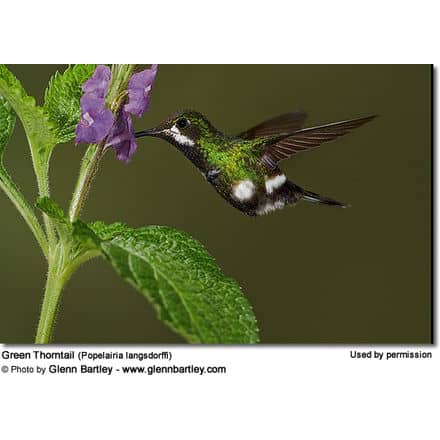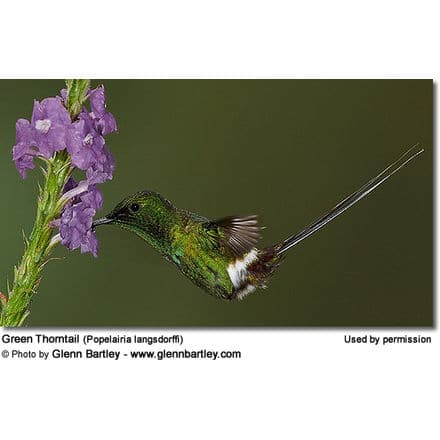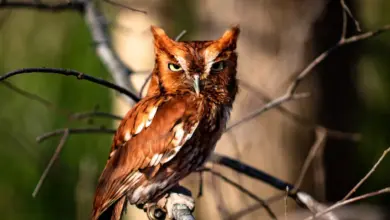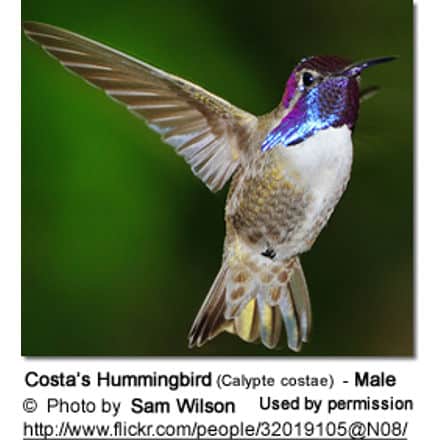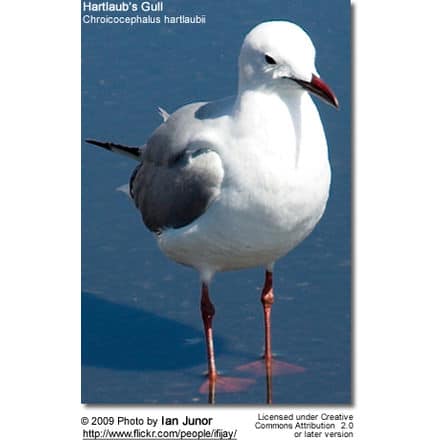Green Thorntail Hummingbirds
The Green Thorntail (Discosura conversii) is a small hummingbird that occurs naturally on the Caribbean slopes of Costa Rica and Panama in Central America; through western Colombia down to western Ecuador in South America.
They are typically found at middle elevations from 700-1400 m, but may move down to lower regions early in the wet season. They generally remain high up in the canopy.
Alternate (Global) Names
Spanish: Cola-de-lira Verde, Colicerda Verde, Coqueta de Cola Celeste, Rabudito Verde … French: Coquette à queue fine, Coquette de Convers, Discosura conversii … Italian: Colibrì codalunga verde, Spinuro verde … German: Dornschwanzelfe, Dornschwanz-Elfe, Grüne Fadenelfel … Latin: Discosura conversii, Popelairia conversii … Czech: kolib?ík trnoocasý, Kolibrík vejírový … Danish: Grøn Tornhale … Finnish: Viherhapsukolibri … Japanese: midoritogeohachidori … Dutch: Groene Draadkolibrie … Norwegian: Grønntrådstjert … Polish: kolcosterek zielony … Russian: ??????? ????????????? ??????? … Slovak: prilbiarik zelený … Swedish: Grön nålstjärt


Description
Green Thorntail is a tiny hummingbird that weighs only about 3 g.
The male averages 10 cm in length. His upper and lower plumage is mostly green, apart from the white rump and a blackish lower rump and tail.
This species was named after the male’s long wire-like tail.
The female is a little smaller – averaging 7.5 – 8 cm in length. She has a conspicuous white moustache and lacks the long tail of the male. She is blackish below with a green chest band.
Hummingbird Resources
- Hummingbird Information
- Hummingbird Amazing Facts
- Attracting Hummingbirds to Your Garden
- Hummingbird Species
- Feeding Hummingbirds
Calls / Vocalization
The Green Thorntail is usually silent, but a quiet chip may occasionally be heard.


Nesting / Breeding
Hummingbirds are solitary in all aspects of life other than breeding; and the male’s only involvement in the reproductive process is the actual mating with the female. They neither live nor migrate in flocks; and there is no pair bond for this species. Males court females by flying in a u-shaped pattern in front of them. He will separate from the female immediately after copulation. One male may mate with several females. In all likelihood, the female will also mate with several males. The males do not participate in choosing the nest location, building the nest or raising the chicks.
The female is responsible for building the cup-shaped nest out of plant fibers woven together and green moss on the outside for camouflage in a protected location in a shrub, bush or tree. She lines the nest with soft plant fibers, animal hair and feather down, and strengthens the structure with spider webbing and other sticky material, giving it an elastic quality to allow it to stretch to double its size as the chicks grow and need more room. The nest is typically found on a low, thin horizontal branch.
The average clutch consists of two white eggs, which she incubates alone, while the male defends his territory and the flowers he feeds on. The young are born blind, immobile and without any down.
The female alone protects and feeds the chicks with regurgitated food (mostly partially-digested insects since nectar is an insufficient source of protein for the growing chicks). The female pushes the food down the chicks’ throats with her long bill directly into their stomachs.
As is the case with other hummingbird species, the chicks are brooded only the first week or two, and left alone even on cooler nights after about 12 days – probably due to the small nest size. The chicks leave the nest when they are about 20 days old. Breeding males are often seen perching on a branch giving a dive display.
Diet / Feeding
The Green Thorntail Hummingbirds primarily feed on nectar taken from a variety of brightly colored, scented small flowers of trees, herbs, shrubs and epiphytes. They favor flowers with the highest sugar content (often red-colored and tubular-shaped) and seek out, and aggressively protect, those areas containing flowers with high energy nectar.They use their long, extendible, straw-like tongues to retrieve the nectar while hovering with their tails cocked upward as they are licking at the nectar up to 13 times per second. Sometimes they may be seen hanging on the flower while feeding.
Many native and cultivated plants on whose flowers these birds feed heavily rely on them for pollination. The mostly tubular-shaped flowers actually exclude most bees and butterflies from feeding on them and, subsequently, from pollinating the plants.
They may also visit local hummingbird feeders for some sugar water, or drink out of bird baths or water fountains where they will either hover and sip water as it runs over the edge; or they will perch on the edge and drink – like all the other birds; however, they only remain still for a short moment.
They also take some small spiders and insects – important sources of protein particularly needed during the breeding season to ensure the proper development of their young. Insects are often caught in flight (hawking); snatched off leaves or branches, or are taken from spider webs. A nesting female can capture up to 2,000 insects a day.
Males establish feeding territories, where they aggressively chase away other males as well as large insects – such as bumblebees and hawk moths – that want to feed in their territory. They use aerial flights and intimidating displays to defend their territories.
